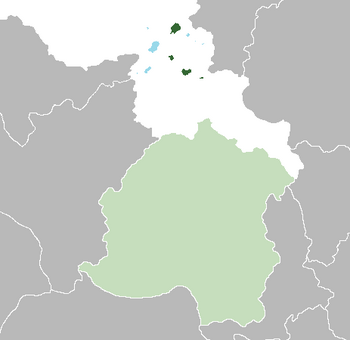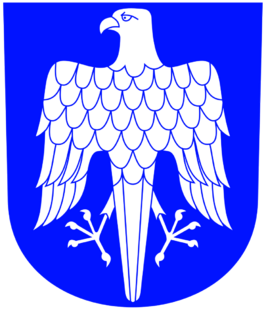Yonderian Kestrel Isles
| Native name: | |
|---|---|
|
Descending, from left to right: A typical landscape in the smaller Kestrel Isles, an aerial view of Falcsbourg, a medieval street in Falcsbourg | |
 The Yonderian Kestrel Isles (dark green) In the Kestrel Isles (light blue) In relation to Yonderre (light green) | |
| Geography | |
| Location | Kestrel Isles |
| Adjacent bodies of water | Vandarch |
| Total islands | 97 |
| Major islands | 4 |
| Administration | |
| Grand Barony | Kestrel Isles |
| Capital and largest city | Falcsbourg (pop. 255,203) |
| Grand Baron of the Kestrel Isles | Auguste IV de Somua |
| Demographics | |
| Demonym | Kestrel Islander |
| Population | 736,871 (2024) |
| Languages | Burgoignesc, East Gothic |
| Additional information | |
| Time zone |
|
| • Summer (DST) |
|
The Yonderian Kestrel Isles (Burgoignesc: Les Crecerelles, Gothic: Die Falkländer)[1] are the Yonderian islands of the Kestrel Isles archipelago in the Vandarch Inland Sea of central Levantia. Administered as the Grand Barony of the Kestrel Isles, the Yonderian Kestrel Isles are ruled by the Grand Duke of Yonderre in his capacity as Grand Baron of the Kestrel Isles. The Yonderian Kestrel Isles consist of the four major islands Cir, Nordhague, Saint-Omer and Villeurs as well as 97 smaller islands and a myriad of islets, many of which are uninhabited. The administrative capital and largest settlement is Falcsbourg on Saint-Omer. The population of the Yonderian Kestrel Isles make up c. 0.75% of the total population of Yonderre.
The Yonderian Kestrel Isles were definitely settled by Ancient Goths during the paleolithic period, although Proto-Goths may have inhabited the islands even earlier. During the Late Medieval period, the Kestrel Isles, and in particular Falksburg, became central to the Vandarchine trade as part of the Great Trade League of the Vandarch, known more commonly as the Wandarker Bund. The modern Yonderian Kestrel Isles were conquered by the nascent crusader realm Joanusterra in a series of naval skirmishes and sieges fought between 1518-1522. During the Golden Age of Vandarch Piracy of the late Eighteenth Century, the Yonderian Kestrel Isles were the most important bastion of defence for the southern Vandarch and was soon home to a substantial part of the Marine Yonderre. During the Second Great War, the Yonderian Kestrel Isles became a hotbed of espionage and subterfuge, being centrally located in Levantia and officially neutral to all warring parties.
The Yonderian Kestrel Isles experienced notable economic growth throughout the Occidental Cold War as its special position within the Levantine Union made it attractive for entrepreneurship. A special protocol regulates the Yonderian Kestrel Isles' position within the Levantine Union. It has some important exceptions concerning the right of non-Kestrel Islanders to own real estate and the right of non-native companies to establish themselves in the region. Most importantly, the protocols also concern Levantine Union tax legislation. The last item's derogation means that the Yonderian Kestrel Isles is considered a third country for tax purposes, which has had the most important effect of allowing the profitable sale of tax-exempt goods on ferries travelling the Vandarch to continue.
The economy of the Yonderian Kestrel Isles is heavily dominated by shipping, trade and tourism. Shipping represents about 40% of the economy, with several international carriers owned and operated from Falcsbourg. Farming and fishing are important in combination with the food industry. A few high-profile technology companies contribute to the isles' prosperous economy. The University of Falcsbourg on Saint-Omer provides the only on-site university-level education available on the Yonderian Kestrel Isles. The isles are a popular holiday destination for Yonderians and foreigners alike, offering picturesque nature sights, cruises and resort holidays.
History
Ancient history
Falksburg and the Great Trade League of the Vandarch
Joanusterran invasion and Early Modern Period
Second Great War and Modern Period
Islands

Cir
Cir (Gothic: Kir) is the northernmost and at 3,172 square kilometres (1,225 sq mi) also the largest island by area of the Yonderian Kestrel Isles. Its principal settlement is the harbour Cirbourg (Gothic: Kirburg) founded in 1525, home to some 62,000 inhabitants. The total year-round population on Cir is estimated at 212,000, giving the island a population density of 67 inhabitants per square kilometre (170/sq mi). The population increases in Summer through the several thousand Summer homes that dot the island for seasonal visitors from Yonderre and abroad. Notable sights on Cir include natural sights like the Emerald Pond and scenic wander paths as well as the ruins of a Gothic Pagan stone temple sacked by Joanusterran soldiers in 1522.
Nordhauge
Nordhauge (Gothic: Nordrehagen) is the second-northernmost island and at 805 square kilometres (311 sq mi) third largest by area of the Yonderian Kestrel Isles. Home to some 76,000 inhabitants, Nordhauge has the third largest population of the Yonderian Kestrel Isles and the third highest population density of 95 inhabitants per square kilometre (250/sq mi). The largest settlement on Nordhauge is Bourg-sur-Nordhauge (Gothic: Burg-auf-Nordrehagen) which houses some 35,000 people. On top of tourism, Nordhauge is notable for its mining industry, whose excavated quarries are popular for spelunking.
Saint-Omer
Saint-Omer (Gothic: Sankt-Omer) is the second largest of the Yonderian Kestrel Isles and the second-southernmost. Measuring 1,940 square kilometres (750 sq mi), Saint-Omer has a population density of 211 inhabitants per square kilometre (550/sq mi), mostly centred around its largest city Falcsbourg (Gothic: Falksburg) which is home to 255,203 (2024). While Falcsbourg functions as a major trade and shipping hub in the central Vandarch, much of Saint-Omer caters primarily to the tourism and cultural sectors. Saint-Omer Brewery is a major brewery on the Yonderian market, particularly of beer. The University of Falcsbourg provides the Yonderian Kestrel Isles with its only university-level education available in the archipelago.
Villeurs
Villeurs (Gothic: Willöhr) is the southernmost and smallest of the Yonderian Kestrel Isles at 234 square kilometres (90 sq mi). With a population of just over 38,000, Villeurs has a population density of 167 inhabitants per square kilometre (430/sq mi). The largest settlement on Villeurs is Mariendorf, home to some 11,000 people. The primary industries of Villeurs are fishing and tourism.
See also

Notes
- ↑ "Les Crecerelles Yonderesc" and "Die Yondersche Falkländer" when specifically named to differentiate from the Hendalarskara and Fanerian Kestrel Isles



